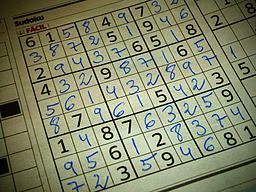Sudoku was a foreign concept to me; I couldn’t understand why people were obsessed with filling in crossword puzzles made up of numbers. I’m not much of a mathematician and I was convinced Sudoku was a math game. Being stranded in eastern Washington 100 miles from the nearest town led me to give Sudoku a try and I’ve been hooked ever since. It’s all about logic and as a librarian and trainer, I do love logic games.
One of the (many ) new trends in learning, both classroom and virtual, is gamification. Games help people learn by getting them involved competitively and helping them find the intrinsic value in the subject matter. However, gamification in its most simple form of pop-quizzes is not quite the same. In developing trainings, many trainers are now adding in components that help participants learn materials by exploring and achieving results on their own and with colleagues.
) new trends in learning, both classroom and virtual, is gamification. Games help people learn by getting them involved competitively and helping them find the intrinsic value in the subject matter. However, gamification in its most simple form of pop-quizzes is not quite the same. In developing trainings, many trainers are now adding in components that help participants learn materials by exploring and achieving results on their own and with colleagues.
For those of us with a competitive streak, this style of training can be highly engaging and fun. And of course there’s that sense of fun and not taking things too seriously. Many people like ice-breakers and games, but there are always those that prefer not to engage in these activities and perceive them as a waste of time. The trick is to make sure that the games and activities contribute to the learning goal. For example, in a communication workshop, you could do an ice-breaker that involves miscommunication. Here’s an example from http://www.trainerbubble.com/
Follow the Leader
Duration: 15 – 30 minutes.
Objective: Useful during a session on body language or communication skills, where you want to highlight how people communicate.
Instructions:
- One person is asked to leave the room. While they are gone the rest of the group identify a ‘leader’. This leader must perform a subtle action that everyone has to follow (i.e., rubbing their nose, licking their lips, scratching their ear, winking, crossing legs, etc.)
- Ask the person to return to the room and explain that they must identify the leader of the group. The leader should alter the action every few minutes with everyone following suit.
- In review, discuss what was noticed and how we interpret and spot body language in others.
There are many great ice-breakers out there and the possibilities are endless.
In addition to ice-breakers and energizers, training can be gamified by its very structure. Take Battle decks as an example.
From http://www.webjunction.org/documents/webjunction/Battledecks_2010.html:
Battledecks is a fun improv exercise that challenges contestants to deliver a presentation on the fly using an unknown slidedeck containing random (and often hilarious) slides. The contestants are judged on their ability to create a coherent presentation that incorporates the slide content smoothly. Laughs and getting through all of the slides on time are a plus.
How it works:
- Each presenter will be given 5 minutes to present 12 slides.
- They have not seen the slide deck before today.
- Attendees will judge the presentations based on a set of criteria.
- You are encouraged to use chat during the presentations.
- There is a slide from one of the conference presentations in each of the decks!
Criteria for judging:
- Believability, humor, and integration with conference theme.
- Ease and presence in online conferencing tool, engaging the audience.
- Presentation flow with minimal pauses or stammering, and getting through all of the slides
Beyond the classroom: Brain Games for Health
Studies show that keeping the brain engaged through games helps stave off the onset of dementia (New England Journal of Medicine, Joe Verghese, M.D., volume=348, issue=25, 2003). Some fun brain games that can be done in trainings or on your own include:
- Write a short story…in only 7 words.
- Here’s a brain workout that will help keep your mind on track. Try these three exercises in simple subtraction:
- Beginning at 200, count backward, subtracting 5 each time (200, 195, 190…).
- Beginning at 150, count backward, subtracting 7 each time (150, 143, 136…).
- Beginning at 100, count backward, subtracting 3 each time (100, 97, 94…).
Let’s keep our brains sharp and engaged and try adding some gaming to our trainings. And just for fun, let’s test your attention skills with this video.
Resources:
http://www.prevention.com/health/brain-games
http://brainrules.blogspot.com/2013/05/brain-rules-for-educators
http://anniemurphypaul.com/2012/12/finding-the-intrinsic-game-in-learning/
http://info.alleninteractions.com/bid/92049/Game-Like-Qualities
http://www.webjunction.org/documents/webjunction/Battledecks_2010.html






